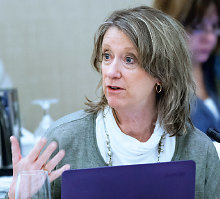Suicide and suicide prevention were the focus of a widely attended briefing at the White House last month. Participants outlined federal initiatives and partnerships among agencies devoted to health care, mental health, law enforcement, veterans affairs, and the military.
Representing APA at the event was Trustee-at-Large Anita Everett, M.D., who told Psychiatric News that the federal focus on suicide is a welcome development for psychiatrists and their patients.
“Suicide is a common component in a day in the life of a practicing psychiatrist,” she said. “We are experienced with the management of suicidal ideation and plans for those who make it into our offices and services. Suicide, however, is a much more common phenomenon within our whole population, and very few of the persons who have serious suicidal ideation actually make it into the offices of psychiatrists or other mental health professionals.
“We see only a small portion of those who are at risk for suicide, and meaningfully addressing our national suicide rate requires involvement beyond traditional clinical settings,” she said. “We need a population approach that includes elements of prevention, early intervention, and increasing access to treatment.”
At the event, Francis Collins, M.D., director of the National Institutes of Health, outlined the scope of suicide: 39,000 lives lost each year to suicide in the United States, 800,000 worldwide. Collins said NIH was spending $2 billion a year on mental health and $60 million on suicide prevention. He said the President’s BRAIN Initiative will provide further insight into brain circuitry to develop better medications to treat depression and schizophrenia, improve diagnosis of depression, and look at ways to deliver faster-working treatments.
Pamela Hyde, J.D., administrator of the Substance Abuse and Mental Health Services Administration (SAMHSA), outlined SAMHSA activities with regard to suicide including the Garrett Lee Smith Suicide Prevention Funds, grants to Native-American tribes for suicide prevention, and the “Your Life Matters” program, a SAMHSA initiative launched with faith communities.
Hyde also said that states must submit suicide prevention strategies as part of their federal grant requests.
Caitlin Thompson, Ph.D., deputy director of the Suicide Prevention Program at the Veterans Administration (VA), noted that 20 percent of people who die by suicide are veterans. She said there are 700 VA employees working on suicide prevention, 300 of whom are assigned to crisis lines, and there are 300 suicide prevention coordinators at VA facilities nationwide. She added that the VA is expanding its suicide prevention and intervention training to all Veterans Health Administration employees and is working with the Department of Defense on a firearms safety program.
“As psychiatrists, we know that suicide impacts virtually everyone, particularly the family and close friends of those left behind,” Everett told Psychiatric News. “We know that we cannot accurately predict which of our patients with suicidal thoughts will go on to attempt suicide.” But Everett noted that there are now more advanced tools—especially the Columbia-Suicide Severity Scale, developed by the Columbia University Suicide Risk Assessment Center—to help reliably stratify risks and proactively manage suicidal ideation in clinical settings.
She said the broad array of projects outlined at the White House was heartening. “The initiatives outlined at this briefing will be far reaching in their impact on our nation’s suicide crisis,” she said. ■
More information on the Obama administration’s suicide-prevention initiatives can be accessed
here.

